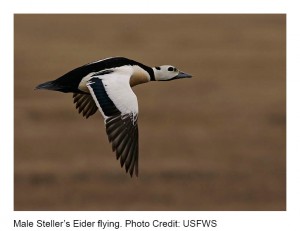A new effort to help a once healthy population of eiders is using unique methods to try to turn sparse numbers around. Stellers eiders used to be common on parts of the YK Delta coast decades ago. Due to some combination of lead poisoning, predators, and changes of habitat they all but disappeared and were listed as threatened under the federal endangered species act in 1997.
Since 1970, only 11 nests have been reported the Y-K Delta. As part of the long recovery plan, biologists are taking the early steps of bringing the birds back. Kate Martin is the Eider Recovery Coordinator with the U.S. Fish and Wildlife Service.
 “We want to start establishing a population of females that would return year after year to produce young,” said Martin.
“We want to start establishing a population of females that would return year after year to produce young,” said Martin.
Bringing back a population is no simple task. Managers are proposing starting with captive bred birds from the Alaska Sea Life Center. They will then learn how to be wild birds.
“One way to do that, which we believe may be the most effective is to actually capture wild hens on the molting grounds, hold them over winter, and bond them with ducklings that are captively bred, and release them as a family group. So that wild hen might teach them what they need to know to be a success bird, how to migrate to appropriate molting areas and appropriate wintering areas,” said Martin.
There are many unknowns about a reintroduction like this. Biologist don’t fully understand how birds determine where to nest. Steller’s eiders from the Russian arctic intermingle with Alaska bound birds during the winter months when they go molt and live in areas along the Alaska Penninsula stretching towards Kodiak.
“One of our uncertainties is how many birds we release on the Y-K Delta will actually return to the YK delta to breed. It’s something we just don’t know until we try, that’s also because we don’t know how apt one female is to return to a place where she was born,” said
A meeting in Bethel will be at the refuge headquarters from 4 to 7 on March 6th. Managers also want to go villages on the central coast area near where the birds would actually be released.
“..[To talk with] people who are closer to areas that we would actually release the birds and talk to them and get input on everything from proposed action to the potential release site any input they would like to give us,” said Martin.
The planning will take a long time. The agency says preparation and methods development will span 3-5 years.
“It’s something we’re committed to trying over several years, it’s going to take that long, it’s a long lived bird, we don’t even expect to see returns of birds for two years after we release them. It’s long term, big, while it’s exciting there’s a lot of pieces to it,” said Martin.
More information on the proposed reintroduction is available here.
Ben Matheson is a contributor with the Alaska Public Radio Network.




